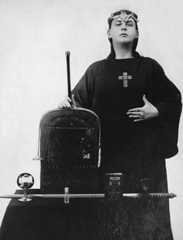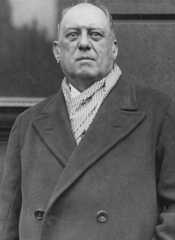Thelema
Our editors will review what you’ve submitted and determine whether to revise the article.
Who established the religion of Thelema?
Thelema was established by the BritishoccultistAleister Crowley in the 1900s.
What is the central text of Thelema?
The central text of Thelema isThe Book of the Law, whichAleister Crowley claimed to have received from a supernatural source in 1904.
What is the main ethical tenet of Thelema?
The main ethical tenet of Thelema is “Do what thou wilt shall be the whole of the Law,” accompanied by “Love is the law, love under will.”
What are some key concepts in Thelema?
Key concepts in Thelema include the pursuit of one’s “True Will,” the practice of magick, and the integration of rituals andYoga into spiritual development.
Thelema,religion established by the BritishoccultistAleister Crowley in the 1900s. It is commonly regarded as a form of bothesotericism andoccultism and sometimes also a type ofmodern Paganism. The tradition centers on a text,The Book of the Law, that Crowley claimed to have received from asupernatural source in 1904. Practitioners of Thelema, called Thelemites, are rarely exclusivist, and thus many Thelemites also practice other religious traditions.
Origins and history
Crowley was born in 1875 to a wealthy middle-class family who adhered to thePlymouth Brethren denomination ofProtestant Christianity. He rebelled against this background and while studying at theUniversity of Cambridge began to explore European traditions commonly labeled under the category of esotericism. Crowley developed a particular interest in ceremonialmagic, which he pursued through the Hermetic Order of the Golden Dawn, an organization he joined in 1898. He further took an interest in Asian religions such asHinduism andBuddhism.
Through his practice of ceremonial magic, Crowley performed variousrituals intended to contact spirits, including while honeymooning with his wife, Rose Kelly, inCairo in 1904. It was at this point that he came to believe that he was being contacted by a supernaturalentity called Aiwass, whom he identified as the messenger of the ancient Egyptian godHorus. Over the course of April 8–10, Crowley transcribed a text that he claimed was audibly delivered to him by Aiwass:Liber AL vel Legis, orThe Book of the Law. Announcing the birth of a newaeon in history, this text also set forth the basis for a new religion, to be called Thelema,thelēma being the ancientGreek word for “will.”
Crowley was initially unsure as to the significance of this revelation, but by 1909 he had come to regard it as being of considerable importance and published it in several editions over subsequent years. After the initial revelation in Cairo, he also produced additional texts that he claimed to have channeled from a supernatural source and that have since been collected together asThe Holy Books of Thelema. None, however, are deemed as important to Thelemites asThe Book of the Law.
Crowley formed his ownesoteric organization, the Argenteum Astrum (“Silver Star”), or A∴A∴, with the English chemist George Cecil Jones in 1907. TheGerman esotericist Theodor Reuss also inducted Crowley into his own initiatory group, the Ordo Templi Orientis (OTO), and in 1912 Crowley was appointed head of its new British branch. In the coming years Crowley reorganized OTO practices around his own Thelemic beliefs and built up a series of communal OTO rituals. The OTO played an important role in promoting Thelema, both inEurope and subsequently inNorth America.
In addition to the OTO’s system of lodges, Crowley promoted communal living according to Thelemic principles. In 1920 he established his Abbey of Thelema atCefalù inSicily, Italy, where he lived with several followers until being expelled by theItalian government in 1923. That decade saw widespread denunciation of Crowley in the British press, in part due to reports about hisdrug use, the death of an Abbey member, and his own tendency to court controversy. One newspaper,John Bull, famously labeled him “the wickedest man in the world.”
At the time of Crowley’s death in 1947, Thelema as an organized movement had seen substantial decline. The last operational OTO lodge, the Agape Lodge inCalifornia, closed in 1948. In accordance with Crowley’s wishes, leadership of the OTO passed to Karl Germer, a German esotericist then based in theUnited States. After Germer’s death in 1962, the organization became largelymoribund, with variouscontenders claiming ownership. After legal challenges, the American Thelemite Grady Louis McMurtry secured control of the OTO trademarks and oversaw efforts to rebuild the organization.

Other Thelemites also established their own organizations or otherwise formed new interpretations of the religion. The American rocket scientistJack Parsons, for instance, believed he had channeled an additional chapter ofThe Book of the Law, titled “Liber 49,” in 1946. Another development appeared in the work of Crowley’s English secretary, Kenneth Grant, who in the 1950s initiated what later became the Typhonian Order. Grant’s approach, sometimes called Typhonian Thelema,integrated Crowley’s teachings withIndian philosophical notions fromTantra andAdvaita Vedanta along with elements from fictional sources such asH.P. Lovecraft’sCthulhu Mythos. Other Thelemites forged their own variants in ensuing decades, resulting in approaches such asTantric Thelema and Thelemicwitchcraft. The spread of theInternet during the 1990s furtherfacilitated the emergence of new approaches as well as the broader dissemination of Thelema.
The OTO continues to operate through lodges in various countries and in 2017 reported about 4,000 members. There are also many Thelemites who remain independent of the organization. Thehistorian of religions Manon Hedenborg White estimated that in 2020 the total number of Thelemites was between 5,000 and 10,000.
Although the number of Thelemites has always remained comparatively small among the Western esotericmilieu, the religion’s influence has been broad. Crowley’s writings were an important influence on Gerald Gardner, the key figure behindWicca, andL. Ron Hubbard was involved in aCalifornian Thelemic group prior to developingScientology. Several Thelemites have also made contributions to the art world, perhaps most notably the American independent filmmakerKenneth Anger, who drew on Thelema in experimental productions such asLucifer Rising (1972).
Beliefs and practices
Thelema centers onThe Book of the Law. This text refers to three divinities: the goddess Nuit, the god Hadit, and their child Ra-Hoor-Khuit. Each of theseentities is associated with a successive aeon in history: Nuit with the matriarchal Aeon ofIsis, Hadit with the patriarchal Aeon ofOsiris, and Ra-Hoor-Khuit with the Aeon ofHorus, which Crowley believed began in 1904. In Crowley’s view, the Aeon of Horus was to be a time of growingindividualism, and its emergence is of profound significance in Thelema.
Attitudes to thistheology nevertheless vary among Thelemites. Some aretheists and believe that Thelema’s deities literally exist, whereas others areatheists and regard such entities as symbolic figures. Moreover, Crowley talked of spiritual entities other than Nuit, Hadit, and Ra-Hoor-Khuit. One of the most significant was Babalon, a goddess whose name derives from theBook of Revelation’swhore of Babylon. In Thelema, Babalon is associated with the destruction of a practitioner’s ego and one’s union with all existence, an important task for a Thelemite’s spiritual development. Elsewhere, Crowley alsoinvoked deities from pre-Christian Europe, notably the ancient Greek godPan.
The Book of the Law offers a clearethical tenet for Thelemites: “Do what thou wilt shall be the whole of the Law.” This concept is accompanied by a related statement, “Love is the law, love under will.” The phrase “Do what thou wilt” can be traced to the work of 16th-century French writerFrançois Rabelais, who is sometimes considered the “first Thelemite” within thecommunity. In the Thelemiccontext, “Do what thou wilt” is not simply an amoral injunction for people to satisfy whatever whim they may have. Instead, it reflects Crowley’s teaching that everyone has their own “True Will,” the central purpose of their existence. Each Thelemite is encouraged to discover and pursue their True Will, a task referred to as the “Great Work,” with Thelema teaching that doing so will place them in harmony with thecosmos. This emphasis onindividualism has contributed to a highly liberal attitude to issues such assexuality among Thelemites, although there are nevertheless ideological divisions between more right-libertarian and left-progressive perspectives in the Thelemic community.
Another key concept in Thelema is “magick,” spelled by Crowley with ak to distinguish it from illusionism or stage “magic.” Crowley definedmagick as “the Science and Art of causing Change to occur in conformity with Will,” something that couldencompass many aspects of a Thelemite’s life and not just the rituals typically associated with ceremonial magic. The latter practices nevertheless play an important role in Thelemic ceremony. Much of Crowley’s approach to the topic was informed by his training in the Hermetic Order of the Golden Dawn, including its use of a series ofinitiatory degrees through which a practitioner can spiritually progress. Unlike the Golden Dawn, Crowley also placed much importance on sex magic, as part of which sexual acts (whether solitary or with a partner) are used to concentrate the Thelemite’s will to achieve specific aims. Moreover, Crowley was highly interested inYoga and was an early advocate for this South Asian religious practice in the West, with many subsequent Thelemitesintegrating Yoga into their lives.
- Key People:
- Aleister Crowley
- Related Topics:
- modern Paganism
In addition to rites that can be performed solo, Crowley devised communal rituals for Thelemites to perform, especially within the OTO. The most notable was thegnostic mass, arite that Crowley developed in 1913 on a trip toMoscow. Although imbued with Thelemic symbolism, the gnostic mass was partly inspired by Crowley’s observation of theEastern Orthodox liturgy atSt. Basil’s Cathedral—though in some ways it is closer in form toRoman Catholicism’sTridentine mass. There are also several celebrations to mark important dates for Thelemites. Some of these, such as a feast tocommemorate Aiwass’s delivery ofThe Book of the Law, arestipulated in the text itself, whereas others, such as Crowley’s birthday or “Crowleymas,” instead celebrate days of significance in the life of Thelema’s prophet.




